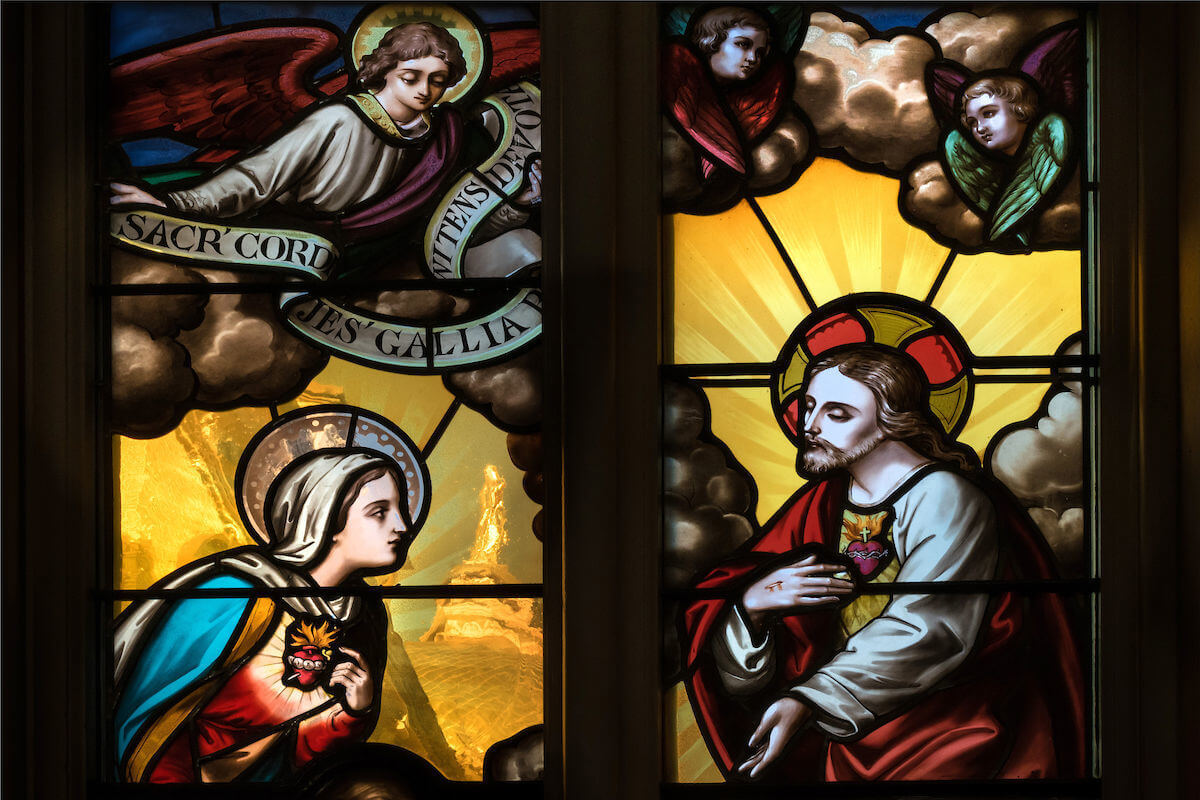With some cloud-gazing imagination, it looks something like a person. The morning sun through a stained-glass window produces a reflection on the floor with vaguely human form. Sometimes, the sunlight overwhelms the camera and washes out the apparition’s colors, but it still retains a sort of shape. This visitor has been present in the sanctuary every time I’ve watched the 10 a.m. Sunday Mass on Catholic TV from Notre Dame’s Basilica of the Sacred Heart, which has sustained me for most of the pandemic.
After the opening blessing, the celebrant welcomes the assembled, including those of us participating virtually. During views of the masked, socially distanced and largely logoed congregation, I look for people I know, reassured after all these years to see familiar priests and professors. Homilies, with or without campus content, often better connect with me than most I hear — a batting average I credit both to their wisdom and my susceptibility to the place. The occasional singing of “Notre Dame, Our Mother” reinforces the bond among attendees, in person or virtual — as does all the Bookstore clothing (including, at home, on me).

It’s usually early in Mass, when student lectors walk to the ambo and the angle shifts to a camera in the west transept, that the sanctuary visitor first appears. It’s primarily visible only from this angle. Shaped by the graceful curve in the front of the sanctuary’s raised floor, the glowing reflection suggests a kneeling rainbow-colored worshiper. I sometimes muse that the almost digitized apparition stands in for me and thousands of other virtual participants.
There’s surely sentimentality all over this, but viewing the basilica Mass is both spiritually nourishing and therapeutic. It hearkens back to a less stressful time than the past year — to that semi-independence of in loco parentis. I’m not just remembering carefree college fun, however. The place and the people also conjure a time of awakening in my faith.
I left home with a faith that was obedient but shallow, something with limits but no vistas, Good Friday but no Easter. Something changed at Notre Dame, though I can remember going to only one Sacred Heart Mass back then.
Mass in Zahm Hall was a far cry from what I had grown up with. For my first daily Mass there, rector Rev. Thomas Tallarida, CSC, ’47, ’61M.A., chose me to do a reading. The eight or so of us sat around the altar on the sanctuary floor. When it was time to read, I stood, but Father Ta told me to sit down, relax and read from where I was. (Good grief! Relax? In Mass?)

Necessarily simple for being in a dorm chapel, those Masses stripped away some things — incense and organ, cassocks and surplices — that, for me, seemed to get in the way of the reason for being there, and they added more inviting elements. We held hands for the Lord’s Prayer, often embraced for the sign of peace (I had always shaken even my mom’s hand) and sang hymns that connected better to our sensibilities (if, perhaps, primarily in musical style). The priests, who lived among us, preached not to our parents’ concerns, but to ours. For the first time, I received Communion from laypeople, my friends. And almost all of my friends were there. Seated together, cross-legged on the floor, those people were part of what made it new and more meaningful. I thought more about the faith, and it also became more felt. The young faces in the basilica today — as well as those closer to my age — help recover that spirit.
Communion brings a reminder of why I’m watching from home. The presider announces instructions for distribution meant to reduce the risk of viral transmission. While the Mass follows diocesan guidelines, basilica rector Rev. Brian Ching, CSC, ’07, ’13M.Div., notes “a few instances where we are a bit more cautious,” recognizing the infectious realities of being on a residential campus.
During Communion, the camera surveys the basilica’s art. Early in this tour, it pauses on the ceiling of the Lady Chapel and superimposes a prayer to Jesus for spiritual Communion for those of us who “cannot at this time receive You sacramentally.” Early in Mass we viewers had been welcomed as participants. There’s a peace in knowing many others are watching in a kind of virtual communion, stretching across an imaginary Zahm Chapel floor. However important, this virtual spirituality is not sufficient, not real presence.
Recently, usually near Communion time, my streaming device has displayed a message asking, “Still watching?” — like a snarky push to get me to go back in person. The note has to do with bandwidth, but my conscience taunts me. So, perhaps, does the figure on the sanctuary floor.
I don’t really believe the visitor represents anyone. It’s an optical illusion, after all. But I think apparitions often reveal something about their witnesses. Rather than a specter — something there — perhaps the light form suggests someone out of place. As a sudden bright spot of light in a movie indicates hole in the film, the shape may connote absence. Mine.
I am writing this between COVID-19 vaccinations, so one hurdle to returning to Mass in person will soon be crossed. I’ll miss the basilica Mass, but maybe having watched it will help recover what I once found. The apparition and even my streaming device may not be scolding me; they may be telling me I’m missed.
Patrick Gallagher lives in Aberdeen, South Dakota, where he works for a statewide foundation.